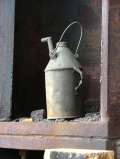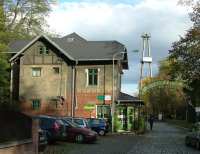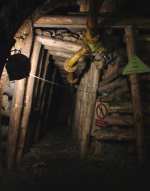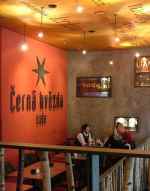
Ostrava
Ostrava has a reputation for being the black heart of the Czech Republic; an ugly, rough coal mining and industrial city. But that's only part of the story.
Czech Republic's third largest city
While it’s true that Ostrava is among the least historic (bombed heavily in WWII) of the Czech Republic’s larger cities, it’s also the greenest and has a vibrant energy thanks partly to the large numbers of young people who come from around the country to study at the University. Ostrava has all the bars, cafes and restaurants you'd expect from the third-largest city in the country, and there are some interestingly specific sites that are quite unlike those you'll get to see in other parts of the country.
Tentative UNESCO listing
 The most outstanding of those is the Vitkovice industrial area. Known locally as Ostravská Hradcana (a self-effacing comparison to the silhouette of Prague castle) the industrial Vitkovice skyline is just as unmistakable and may soon have another thing in common with the real Hradcany, if UNESCO decides to go ahead and protect the area as a site of world heritage importance. The rusted dinosaur landscape of disused blast furnace towers, tanks and conveyor belts is considered unique for its combination of mining, processing and manufacturing on one site. The most outstanding of those is the Vitkovice industrial area. Known locally as Ostravská Hradcana (a self-effacing comparison to the silhouette of Prague castle) the industrial Vitkovice skyline is just as unmistakable and may soon have another thing in common with the real Hradcany, if UNESCO decides to go ahead and protect the area as a site of world heritage importance. The rusted dinosaur landscape of disused blast furnace towers, tanks and conveyor belts is considered unique for its combination of mining, processing and manufacturing on one site.
Tour coal mines and steel works
 The coal mine and blast furnaces have been disused since the early 1990’s when the newly democratic government decided it wasn’t appropriate to a have a huge coalfired industrial complex in the middle of a city of 300,000 inhabitants. The steelworks continued to operate but the unemployment caused by the closure of the mines was such a heavy burden that some locals felt Ostrava was being punished for being such a reliable bastion of working-class support for the old Communist regime. The coal mine and blast furnaces have been disused since the early 1990’s when the newly democratic government decided it wasn’t appropriate to a have a huge coalfired industrial complex in the middle of a city of 300,000 inhabitants. The steelworks continued to operate but the unemployment caused by the closure of the mines was such a heavy burden that some locals felt Ostrava was being punished for being such a reliable bastion of working-class support for the old Communist regime.
Interactive museum of mining
 The other interesting industrial site is the Mining Museum, right out behind the train station at the other end of town. The bus trip there is fairly straightforward and then it’s a five minute walk to the museum entrance. There are three tours, each of which takes about an hour to complete. I started at the mine rescue exhibit, which begins with an elegant and understated memorial to local mine rescuers who died doing their jobs. There are displays of breathing and diving equipment and an underground replica of a rescue station and training chamber. The training chamber is mostly for children to try squeezing through tight spaces in the dark, but eloquently suggests the horror of being trapped in a mine, especially if there’s flooding involved. The other interesting industrial site is the Mining Museum, right out behind the train station at the other end of town. The bus trip there is fairly straightforward and then it’s a five minute walk to the museum entrance. There are three tours, each of which takes about an hour to complete. I started at the mine rescue exhibit, which begins with an elegant and understated memorial to local mine rescuers who died doing their jobs. There are displays of breathing and diving equipment and an underground replica of a rescue station and training chamber. The training chamber is mostly for children to try squeezing through tight spaces in the dark, but eloquently suggests the horror of being trapped in a mine, especially if there’s flooding involved.
Disused coal mine
 The second tour is of an actual coal mine, focusing on the techniques of extracting coal and the conditions under which miners worked. The guide is an cheerful old miner with a relaxed manner and, while the old wooden part of the mine is a mock up, the modern steel-reinforced section is an authentic disused coal mine. As on most underground tours you’ll have a chance to experience total darkness. The third tour is of the exhibition building, but I didn’t make it in time for this one. It displays mining equipment, the development of mining lamps and illumination and talks about the different professions associated with mining. The second tour is of an actual coal mine, focusing on the techniques of extracting coal and the conditions under which miners worked. The guide is an cheerful old miner with a relaxed manner and, while the old wooden part of the mine is a mock up, the modern steel-reinforced section is an authentic disused coal mine. As on most underground tours you’ll have a chance to experience total darkness. The third tour is of the exhibition building, but I didn’t make it in time for this one. It displays mining equipment, the development of mining lamps and illumination and talks about the different professions associated with mining.
Play hard on Stodolni
It's not just work, work, work though. There’s a rich cultural life in Ostrava, and it boasts an energetic nightlife zone that rivals cities ten times the size. Along Stodolní Ulice and neighbouring lanes dozens and dozens, perhaps a hundred bars and clubs stand shoulder to shoulder and combined with the exuberance of the locals and the ‘work hard, play hard’ ethic you can imagine the kind of night out you might have.
Colours of Ostrava
 If you happen to be visiting in June, Colours of Ostrava is one of the country’s best music festivals, with 16 stages, a leaning towards world music and past headliners like Marianne Faithful, Robert Plant and Goran Bregovic. There are also plenty of good cafes in which to pass an hour or two with a coffee and something to read. My two favourites are the café in the multi-floor bookstore on the main square and the Cerná Hvezda (Black Star) on the corner of Stodolní and Nadražní. If you happen to be visiting in June, Colours of Ostrava is one of the country’s best music festivals, with 16 stages, a leaning towards world music and past headliners like Marianne Faithful, Robert Plant and Goran Bregovic. There are also plenty of good cafes in which to pass an hour or two with a coffee and something to read. My two favourites are the café in the multi-floor bookstore on the main square and the Cerná Hvezda (Black Star) on the corner of Stodolní and Nadražní.
Churches, castle and a brewery
 There’s also the local museum, some interesting churches to visit (including the Cathedral of the Holy Saviour) and the Moravo-Silesian castle, which has remained intact despite sinking an amazing 17 metres due to undermining! The museum of firefighting will be interesting to some and tours of the local Ostravar brewery include tastings. Or you might prefer to try the beer in its native habitat; a Banik football club home game. There’s also the local museum, some interesting churches to visit (including the Cathedral of the Holy Saviour) and the Moravo-Silesian castle, which has remained intact despite sinking an amazing 17 metres due to undermining! The museum of firefighting will be interesting to some and tours of the local Ostravar brewery include tastings. Or you might prefer to try the beer in its native habitat; a Banik football club home game.
Black star on the rise
So there’s plenty to see and do here, and while Ostrava is far from the country’s top tourist destination, anyone who dismisses it as a worthless industrial wasteland is either being unfair or simply hasn’t been there and is making things up.
 Ostrava's steel heart has opened up, the rainbow colours of the music festival and Stodolni are outshining the black star and, in contrast to more famous and heavily trafficked Czech tourist destinations, there’s never been a better time to visit Ostrava than now. Ostrava's steel heart has opened up, the rainbow colours of the music festival and Stodolni are outshining the black star and, in contrast to more famous and heavily trafficked Czech tourist destinations, there’s never been a better time to visit Ostrava than now. |

 The most outstanding of those is the Vitkovice industrial area. Known locally as Ostravská Hradcana (a self-effacing comparison to the silhouette of Prague castle) the industrial Vitkovice skyline is just as unmistakable and may soon have another thing in common with the real Hradcany, if UNESCO decides to go ahead and protect the area as a site of world heritage importance. The rusted dinosaur landscape of disused blast furnace towers, tanks and conveyor belts is considered unique for its combination of mining, processing and manufacturing on one site.
The most outstanding of those is the Vitkovice industrial area. Known locally as Ostravská Hradcana (a self-effacing comparison to the silhouette of Prague castle) the industrial Vitkovice skyline is just as unmistakable and may soon have another thing in common with the real Hradcany, if UNESCO decides to go ahead and protect the area as a site of world heritage importance. The rusted dinosaur landscape of disused blast furnace towers, tanks and conveyor belts is considered unique for its combination of mining, processing and manufacturing on one site. The coal mine and blast furnaces have been disused since the early 1990’s when the newly democratic government decided it wasn’t appropriate to a have a huge coalfired industrial complex in the middle of a city of 300,000 inhabitants. The steelworks continued to operate but the unemployment caused by the closure of the mines was such a heavy burden that some locals felt Ostrava was being punished for being such a reliable bastion of working-class support for the old Communist regime.
The coal mine and blast furnaces have been disused since the early 1990’s when the newly democratic government decided it wasn’t appropriate to a have a huge coalfired industrial complex in the middle of a city of 300,000 inhabitants. The steelworks continued to operate but the unemployment caused by the closure of the mines was such a heavy burden that some locals felt Ostrava was being punished for being such a reliable bastion of working-class support for the old Communist regime.  The other interesting industrial site is the Mining Museum, right out behind the train station at the other end of town. The bus trip there is fairly straightforward and then it’s a five minute walk to the museum entrance. There are three tours, each of which takes about an hour to complete. I started at the mine rescue exhibit, which begins with an elegant and understated memorial to local mine rescuers who died doing their jobs. There are displays of breathing and diving equipment and an underground replica of a rescue station and training chamber. The training chamber is mostly for children to try squeezing through tight spaces in the dark, but eloquently suggests the horror of being trapped in a mine, especially if there’s flooding involved.
The other interesting industrial site is the Mining Museum, right out behind the train station at the other end of town. The bus trip there is fairly straightforward and then it’s a five minute walk to the museum entrance. There are three tours, each of which takes about an hour to complete. I started at the mine rescue exhibit, which begins with an elegant and understated memorial to local mine rescuers who died doing their jobs. There are displays of breathing and diving equipment and an underground replica of a rescue station and training chamber. The training chamber is mostly for children to try squeezing through tight spaces in the dark, but eloquently suggests the horror of being trapped in a mine, especially if there’s flooding involved. The second tour is of an actual coal mine, focusing on the techniques of extracting coal and the conditions under which miners worked. The guide is an cheerful old miner with a relaxed manner and, while the old wooden part of the mine is a mock up, the modern steel-reinforced section is an authentic disused coal mine. As on most underground tours you’ll have a chance to experience total darkness. The third tour is of the exhibition building, but I didn’t make it in time for this one. It displays mining equipment, the development of mining lamps and illumination and talks about the different professions associated with mining.
The second tour is of an actual coal mine, focusing on the techniques of extracting coal and the conditions under which miners worked. The guide is an cheerful old miner with a relaxed manner and, while the old wooden part of the mine is a mock up, the modern steel-reinforced section is an authentic disused coal mine. As on most underground tours you’ll have a chance to experience total darkness. The third tour is of the exhibition building, but I didn’t make it in time for this one. It displays mining equipment, the development of mining lamps and illumination and talks about the different professions associated with mining. If you happen to be visiting in June, Colours of Ostrava is one of the country’s best music festivals, with 16 stages, a leaning towards world music and past headliners like Marianne Faithful, Robert Plant and Goran Bregovic. There are also plenty of good cafes in which to pass an hour or two with a coffee and something to read. My two favourites are the café in the multi-floor bookstore on the main square and the Cerná Hvezda (Black Star) on the corner of Stodolní and Nadražní.
If you happen to be visiting in June, Colours of Ostrava is one of the country’s best music festivals, with 16 stages, a leaning towards world music and past headliners like Marianne Faithful, Robert Plant and Goran Bregovic. There are also plenty of good cafes in which to pass an hour or two with a coffee and something to read. My two favourites are the café in the multi-floor bookstore on the main square and the Cerná Hvezda (Black Star) on the corner of Stodolní and Nadražní. There’s also the local museum, some interesting churches to visit (including the Cathedral of the Holy Saviour) and the Moravo-Silesian castle, which has remained intact despite sinking an amazing 17 metres due to undermining! The museum of firefighting will be interesting to some and tours of the local Ostravar brewery include tastings. Or you might prefer to try the beer in its native habitat; a Banik football club home game.
There’s also the local museum, some interesting churches to visit (including the Cathedral of the Holy Saviour) and the Moravo-Silesian castle, which has remained intact despite sinking an amazing 17 metres due to undermining! The museum of firefighting will be interesting to some and tours of the local Ostravar brewery include tastings. Or you might prefer to try the beer in its native habitat; a Banik football club home game. Ostrava's steel heart has opened up, the rainbow colours of the music festival and Stodolni are outshining the black star and, in contrast to more famous and heavily trafficked Czech tourist destinations, there’s never been a better time to visit Ostrava than now.
Ostrava's steel heart has opened up, the rainbow colours of the music festival and Stodolni are outshining the black star and, in contrast to more famous and heavily trafficked Czech tourist destinations, there’s never been a better time to visit Ostrava than now. 
